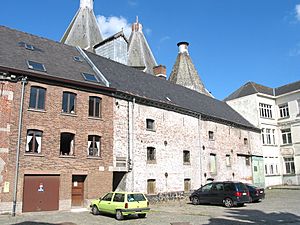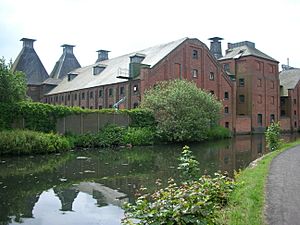Malt house facts for kids
A malt house (also called a malt barn or maltings) is a special building where cereal grain (like barley) is turned into malt. This happens by soaking the grain in water, letting it start to sprout, and then drying it to stop it from growing further. Malt is an important ingredient for making beer, whisky, and some foods. Most old malt houses were replaced by bigger, more modern factories in the 1900s. Many of these old buildings have found new lives, like Snape Maltings in England, which is now a concert hall!
Contents
How Malt is Made: The Process
Making malt involves a few key steps: soaking the grain, letting it sprout, and then drying it. This process changes the grain, making it sweet and ready for use.
Traditional Floor Malting
In the past, most malt was made using a method called floor malting. Here's how it worked:
- Soaking the Grain: First, the grain was put into a large pit or tank called a steeping pit. It would soak in water for a day or more. This made the grain swell up, getting ready to sprout.
- Starting to Sprout: After soaking, the water was drained. The wet grain was then piled up in a special area called a couch. Here, it would start to warm up and begin to germinate (sprout).
- Spreading it Out: The grain was then spread out on a large floor. Workers would turn it regularly to make sure it sprouted evenly. This part of the process could take about two weeks. As the grain sprouted, it gave off a nice smell, and tiny roots would appear. The inside of the grain became soft and sweet.
- Drying the Malt: Before the sprouts grew too long, the process was stopped. The grain was moved to a special oven called a kiln. It stayed there for a few days to dry completely. The heat was slowly increased to get the right color and flavor for the malt. Finally, the dried malt was cleaned to remove any shoots and stored to develop its full flavor.
Modern Saladin Malting
The Saladin system is a more modern way to make malt using machines. It's designed to be very efficient.
- Washing and Soaking: The barley is first soaked and washed to remove any dirt or floating bits.
- Controlled Soaking: It then goes through several steps of soaking and drying, with carbon dioxide (CO2) removed. This helps control the process precisely.
- Germination Box: Finally, the grain is moved into a special container called a Saladin box, where it sprouts under carefully controlled conditions.
Steep, Germinate, and Kilning Vessel
Another modern method uses a single large vessel (a big tank) for all three main steps: soaking, sprouting, and drying. Unlike the traditional floor method where the grain moves horizontally, in this system, the grain moves vertically. This method is mostly used in very large factories because it costs a lot to set up.
Malt Houses in the United Kingdom
In the 1700s, many villages in the UK had their own malt house. These small buildings supplied local pubs and people who brewed their own drinks. Malt houses were usually long, low buildings, often just one or two stories high. Because high temperatures could stop the barley from sprouting, many malt houses only worked in the winter. This was good because it gave jobs to farm workers when they weren't busy with crops.
As time went on, especially in the 1800s, many small breweries closed. Larger breweries and special malt-making companies started to build their own bigger maltings. These new buildings were often multi-story and could operate all year round. It was also easier to transport malt than raw barley, so many big breweries built their maltings near railway lines in areas where barley was grown.
Towards the end of the 1800s, a new method called pneumatic malting was invented. This used air to control the temperature and speed up sprouting. This meant that huge malting floors were no longer needed. However, these new methods used a lot of power, so traditional floor malting continued for a long time. Today, only a few traditional malting floors are still in use.
Famous Malt House Buildings
Many old malt houses are now protected historic buildings. Here are a few examples:
- Ye Old Corner Cupboard in Winchcombe, Gloucestershire: This building was once a farmhouse and now an inn. It has a 19th-century malthouse attached.
- The Malt House in Alton, Staffordshire: This 17th-century house has an attached granary and an underground maltkiln.
- Great Cliff Malt House in Chevet, West Yorkshire: Built in the early 1600s, this malt house has heavy wooden beams and a special lime-ash floor.
- Warminster Maltings in Wiltshire: Dating from the 1700s and rebuilt in 1879, you can take tours here.
- Tuckers Maltings in Newton Abbot, Devon: Built in 1900, this building is also open for guided tours.
- Great Ryburgh Maltings in Norfolk: This site has been making malt for 200 years. The oldest building from the 1890s still has three working floors.
- Dereham Maltings in Dereham, Norfolk: Built in 1881, this malt house was turned into apartments after production moved to Great Ryburgh.
- Ditherington Flax Mill in Shrewsbury, Shropshire: This building was originally a flax mill. It was turned into maltings in 1898 and is famous for its special construction.
- Bass Maltings in Sleaford, Lincolnshire: Built between 1901 and 1907, this is the largest group of maltings of its kind in England. It hasn't been used since 1959.
The Old Malt Tax
A special tax on malt was introduced in Britain in 1697. It was finally removed in 1880.
The tax rate for malted barley started at a small amount in 1697. It slowly increased over the years, especially during the wars with France in the late 1700s and early 1800s. By 1865, this tax brought in a lot of money for the government.
There were also many rules about how malt could be made because of the tax. For example, the soaking tanks had to be built in a certain way so tax officers could easily measure the grain. Malt makers had to tell the tax officers before they started soaking any grain. They also had strict rules about how long the grain had to stay in water and how it was spread out. Tax officers would carefully measure the grain at different stages to figure out how much tax was owed.






